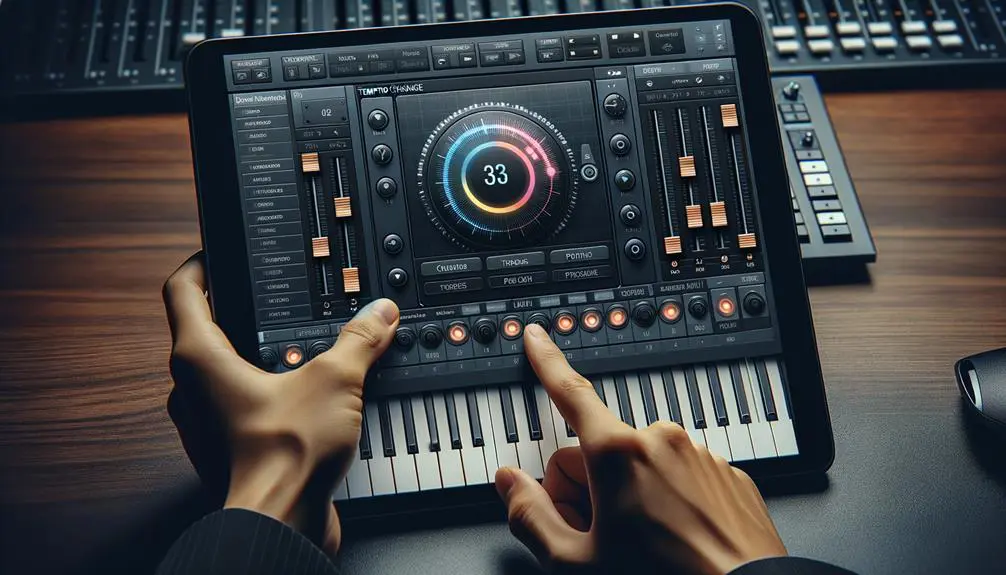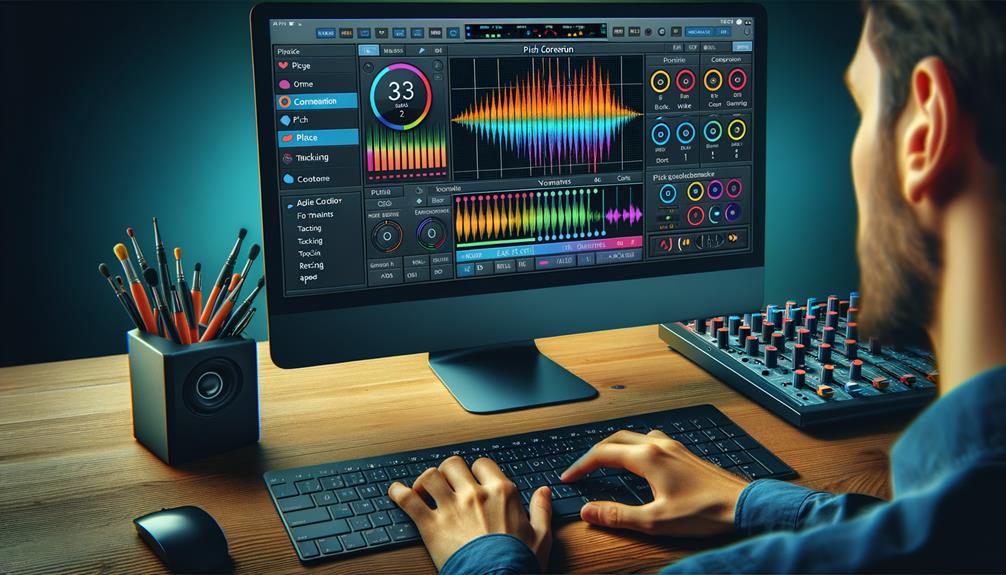To mix Dolby Atmos in Logic Pro X for immersive, 3D soundscapes, start by setting your sample rate to 48 kHz or 96 kHz for peak clarity. Configure your surround format, typically 7.1.2, and make certain your I/O buffer is set appropriately, i.e., 512 samples for 48 kHz. Use the 3D Object Panner to position sound dynamically within the space. Apply precision automation for engaging spatial effects like reverb and delay. Maintain high-fidelity monitoring to guarantee accurate sound translation. Regularly test mixes across various systems to confirm consistency. Exploring the intricacies of these techniques will deepen your mixing proficiency.
Key Takeaways
- Set sample rate to 48 kHz or 96 kHz and adjust I/O buffer size for optimal Dolby Atmos compatibility.
- Configure the project to a surround format like 7.1.2 for more channel flexibility and immersive sound.
- Use the 3D Object Panner in Logic Pro X to position audio elements precisely within a 3D soundscape.
- Regularly calibrate monitoring conditions and utilize the Dolby Atmos Renderer for accurate spatial audio playback.
- Experiment with advanced panning techniques, reverb, and delay to enhance auditory depth and spatial effects.
Project Setup Essentials
When starting on a Dolby Atmos mixing project in Logic Pro X, it’s essential to meticulously configure your project setup to guarantee seamless integration and ideal performance.
Initiate a new project by setting the sample rate to 48 kHz or 96 kHz, ensuring compatibility with Dolby Atmos mixing in Logic Pro. Adjust the I/O buffer size; a minimum of 512 samples for 44.1 kHz or 48 kHz, and 1024 samples for 88.2 kHz or 96 kHz, optimizing audio production performance.
The default surround format is 7.1.2, adjustable to 5.1 or 7.1 within the project settings. Output settings must align with your immersive speaker setup, facilitating accurate spatial audio distribution. Additionally, understanding the importance of monitor mix can significantly enhance your workflow during the mixing process.
Regularly verify room calibration for precise spatial audio tools functionality.
Configuring Spatial Tools
To achieve ideal Dolby Atmos compatibility in Logic Pro X, begin by setting your project sample rate to either 48 kHz or 96 kHz, ensuring high audio clarity.
Configure the I/O buffer size to a minimum of 512 samples for 48 kHz projects, or 1024 samples for higher rates, to maintain smooth performance during the mixing process.
It is essential to select the appropriate surround format, such as 7.1.2, within the project settings under File > Project Settings > Audio, aligning with your output requirements and speaker configuration.
Selecting Surround Format
Configuring the surround format is a significant step in establishing the spatial framework for a Dolby Atmos mix in Logic Pro X. The default surround format for Dolby Atmos projects is 7.1.2, providing a surround bed with height channels for immersive audio experiences.
To modify this, navigate to File > Project Settings > Audio and select your preferred configuration from the Surround Format pop-up menu, such as 5.1 or 7.1. Your choice directly influences available output channels, essential for effective audio routing in 3D soundscapes.
Surround bed tracks can be mono, stereo, or multi-channel, ensuring adaptability across various playback systems. Proper configuration is important for maximizing immersion and ensuring mixes translate well across diverse listening environments, enhancing your creative mixing techniques.
Adjusting Sample Rate
In the field of Dolby Atmos mixing within Logic Pro X, adjusting the sample rate is pivotal to achieving ideal audio fidelity and performance.
For best Dolby Atmos mixing, it is essential to configure your project to a sample rate of either 48 kHz or 96 kHz. These rates are recommended to guarantee seamless integration with Logic Pro X’s spatial audio tools, which are instrumental in crafting a 3D soundscape.
Using lower sample rates, such as 44.1 kHz or 88.2 kHz, may necessitate real-time conversion, potentially impacting performance based on project complexity.
Regularly verifying sample rate settings guarantees compatibility with Dolby Atmos requirements, maintaining high audio fidelity throughout the mixing process. This foundational step is critical for immersive sound design.
Setting I/O Buffer
Optimizing the I/O buffer size is a critical step in configuring spatial tools for Dolby Atmos mixing in Logic Pro X. For peak performance, set the I/O buffer size to a minimum of 512 samples at 44.1 kHz or 48 kHz sample rates, and 1024 samples for 88.2 kHz or 96 kHz projects. Adjust these settings via Preferences > Audio to balance latency and processing demands. Lower buffer sizes reduce latency, essential for real-time monitoring, while larger buffers enhance stability for CPU-intensive tasks. Regularly monitor project settings, especially when integrating spatial audio tools and audio plugins, to maintain stability without compromising on latency.
”’markdown
| Sample Rate (kHz) | Recommended I/O Buffer Size (Samples) |
|---|---|
| 44.1 or 48 | 512 |
| 88.2 or 96 | 1024 |
”’
Surround Format Options
When starting on a Dolby Atmos project in Logic Pro X, understanding the available surround format options is vital for achieving the desired immersive audio experience.
The default surround format is 7.1.2, offering a thorough audio bed with height channels for enhanced spatial placement. Users can adjust the surround format to 5.1 or 7.1 via the Project Settings under the Audio section.
Each format influences the available output channels, with 5.1 providing six and 7.1 offering eight channels. This flexibility is significant for matching the speaker configuration, ensuring accurate audio routing.
Selecting the appropriate surround format through the Project Settings pop-up menu allows adaptation to various playback systems, thereby optimizing the Dolby Atmos mixing environment for an immersive sound experience.
Crafting Immersive Soundscapes
To craft immersive soundscapes in Logic Pro X, mastering surround panning is essential for positioning audio elements in a three-dimensional space, thereby enhancing the overall depth of your mix.
By meticulously adjusting elevation and spread parameters, audio engineers can create dynamic movement and spatial depth, transforming the listener’s experience.
Employing the 3D Object Panner and integrating spatial effects such as reverb and delay further enriches the auditory environment, ensuring an enchanting and multidimensional sound palette. Additionally, applying panning techniques can significantly enhance the clarity and width of your stereo image, making the overall mix more engaging.
Mastering Surround Panning
A significant element in crafting immersive soundscapes through Dolby Atmos in Logic Pro X is mastering surround panning, which allows for precise spatial placement of audio elements within a 3D sound environment.
The Surround Panner window in Logic Pro X provides essential controls for adjusting elevation and distance, fundamental for achieving depth in a Dolby Atmos mix.
By utilizing the 3D Object Panner, sound objects can be manipulated in a three-dimensional sound space, enhancing dynamic spatial audio playback.
Properly configuring the project surround format, such as 7.1.2, guarantees compatibility for an engaging Dolby Atmos mix.
Experimentation with various placements and panning techniques is essential to precisely position audio elements, fully exploiting the immersive potential of Dolby Atmos mixing.
Enhancing Audio Depth
Building upon the foundation of mastering surround panning, enhancing audio depth plays a pivotal role in crafting truly immersive soundscapes with Logic Pro X’s Dolby Atmos capabilities.
Utilizing the surround panner, position audio elements precisely within a three-dimensional space, controlling their movement seamlessly.
Explore elevation controls in the 7.1.2 bed tracks to introduce height, adding realism and depth to your mix.
The 3D Object Panner is indispensable for dynamically placing object tracks, ensuring the spatial effects contribute effectively to the immersive experience.
Integrate reverb and spatial effects to develop ambient environments, enhancing depth and envelopment.
Regularly monitor the mix in various playback formats, such as binaural and 7.1.4, to guarantee the immersive experience translates accurately across different listening contexts.
Advanced Mixing Techniques
Harness the full potential of Dolby Atmos in Logic Pro X by delving into advanced mixing techniques that boost your audio projects to new dimensions of depth and immersion.
Key strategies include:
- 3D Object Panner Mastery: Utilize the 3D Object Panner to accurately position sound elements in the three-dimensional space. This tool is essential for achieving dynamic movement and depth in your mixes, enhancing the immersive quality of your audio experiences.
- Precision Automation: Experiment with automation on surround and object panner parameters to craft engaging audio shifts. This technique considerably enhances the spatial effects and realism of your sound design.
- High-Fidelity Monitoring: Regularly leverage higher sample rates like 96 kHz and monitor your mix with the Dolby Atmos Renderer. This guarantees peak audio clarity and spatial representation across diverse playback systems. Additionally, maintaining optimal reverb settings is crucial for ensuring that spatial effects do not overwhelm the clarity of individual audio elements.
Finalizing Atmos Mixes
Mastering advanced mixing techniques in Dolby Atmos within Logic Pro X sets the stage for the crucial process of finalizing your Atmos mixes.
Begin by confirming your project is configured with a sample rate of either 48 kHz or 96 kHz, and an I/O buffer size of at least 512 samples to uphold audio integrity during rendering.
Proper room calibration and monitoring are essential for ensuring your spatial audio translates accurately to the final output.
Employ the Dolby Atmos Renderer to facilitate ideal playback and adherence to immersive sound standards.
Consistently verify audio levels to avert synchronization discrepancies.
During exporting, choose suitable audio formats, applying mastering techniques to refine the mix, ensuring compatibility across diverse playback systems for a professional final product. Additionally, it is crucial to ensure loudness normalization standards are met for consistent volume across different platforms.
Community and Resources
The vibrant community surrounding Dolby Atmos mixing in Logic Pro X serves as an essential resource for both novice and seasoned audio engineers. This community is a hub for exchanging insights on mixing techniques, optimizing setups, and exploring the creative potential of immersive sound.
Engaging in forums provides invaluable access to industry news and practical advice on spatial audio design. Community support is fostered through shared experiences and expert insights, enhancing one’s understanding of Dolby Atmos workflows.
Key community resources include:
- Active Forums: Discuss connecting audio interfaces and real-time playback optimization.
- Courses and Materials: Continuous updates guarantee relevance and foster collaboration.
- Peer Feedback: Leverage advice from experienced users to refine your Logic Pro X projects.
This collaborative environment drives innovation in immersive audio.
Frequently Asked Questions
Can You Mix Dolby Atmos in Logic?
Yes, Dolby Atmos can be mixed in Logic Pro X. This platform supports advanced audio mixing, enabling spatial audio for immersive experiences. It utilizes audio plugins and mixing techniques for sound design in music production, surround sound, and home theater applications.
Does Dolby Atmos Support 3D Audio?
Yes, Dolby Atmos supports 3D audio, offering advanced sound design capabilities. This spatial audio format enhances the immersive experience in audio engineering, enabling precise sound mixing and surround sound placement, essential for innovative audio production and creative workflow.
Is Dolby Atmos Immersive Audio?
Dolby Atmos is indeed an immersive audio technology that revolutionizes sound design by enhancing spatial awareness and sound localization. It raises listener engagement through multi-dimensional soundscapes, offering unparalleled surround sound, cinematic audio depth, and innovative audio engineering methods.
What Software Is Used to Mix Dolby Atmos?
Logic Pro X is a premier software for Dolby Atmos mixing, offering sophisticated mixing techniques, robust software features, and extensive audio plugins. It supports spatial audio, enhances sound design, and optimizes workflow efficiency across various audio formats and production tools.
Conclusion
The integration of Dolby Atmos in Logic Pro X facilitates the creation of immersive 3D soundscapes through meticulous project setup and spatial configuration. By exploring various surround format options and employing advanced mixing techniques, sound engineers can craft dynamic audio experiences. Finalizing Atmos mixes requires precision and adherence to industry standards. Engaging with the community and utilizing available resources enhances proficiency and innovation, ensuring that the resulting soundscapes are of the highest auditory quality and impact.



